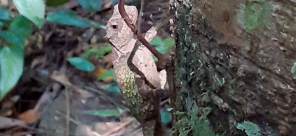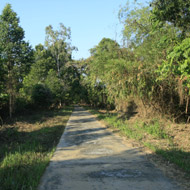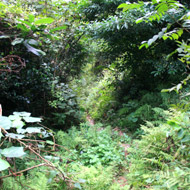Birds of Vietnam, Bird Species in Vietnam

Let's join AdventureGreen on our bird quests to learn about the different birds and bird species in Vietnam. Here you can find out more about the birding spots that these bird species are found.
- Order: Passeriformes
- Family: Estrildidae
- Genus: Lonchura
Scaly-breasted munia
or spotted munia, known in the pet trade as nutmeg mannikin or spice finch
(Di đá, Lonchura punctulata)
The scaly-breasted munia or spotted munia (Lonchura punctulata), known in the pet trade as nutmeg mannikin or spice finch, is a sparrow-sized estrildid finch native to tropical Asia.
The bird occurs from India and Sri Lanka east to Indonesia and the Philippines
The name mannikin is from Middle Dutch mannekijn 'little man'.
Lonchura the Ancient Greek lonkhē meaning "spear-head" or "lance" with oura meaning "tail".
punctulata: Latin punctulatus spotted, dotted.
- Order: Passeriformes
- Family: Estrildidae
- Genus: Lonchura
Tricoloured munia
(Di đầu đen, Lonchura malacca)
The tricoloured munia (Lonchura malacca) is an estrildid finch, native to Bangladesh, India, Sri Lanka, Pakistan, and southern China.
The name mannikin is from Middle Dutch mannekijn 'little man'.
Lonchura the Ancient Greek lonkhē meaning "spear-head" or "lance" with oura meaning "tail".
- Order: Passeriformes
- Family: Estrildidae
- Genus: Amandava
Red avadavat
or red munia or strawberry finch
(Chim mai hoa, Amandava amandava)
The red avadavat (Amandava amandava), red munia or strawberry finch, is a sparrow-sized bird of the family Estrildidae.
The bird is found in the open fields and grasslands of tropical Asia.
The word Estrildidae is derived from the Greek word "estrildis" meaning "sparrow-like," and the Latin suffix "-idae," denoting a family of animals.
The species name of amandava and the common name of avadavat are derived from the city of Ahmedabad in Gujarat, India.
- Order: Passeriformes
- Family: Estrildidae
- Genus: Erythrura
Pin-tailed parrotfinch
(Di xanh, Erythrura prasina)
The pin-tailed parrotfinch (Erythrura prasina) is a common species of estrildid finch found in Southeast Asia: Malaysia, Brunei, Cambodia, Indonesia, Laos, Burma, Vietnam, Thailand and China.
The word Estrildidae is derived from the Greek word "estrildis" meaning "sparrow-like," and the Latin suffix "-idae," denoting a family of animals.
Erythrura: Greek eruthros red.
prasina Latin prasinus leek-green (from Greek prasinos leek-green).
- Order: Passeriformes
- Family: Estrildidae
- Genus: Lonchura
White-rumped munia
or white-rumped mannikin, sometimes called striated finch
(Di cam, Lonchura striata)
The white-rumped munia (Lonchura striata) or white-rumped mannikin, sometimes called striated finch in aviculture, is a small passerine bird from the family of waxbill "finches" (Estrildidae).
The bird is native to tropical continental Asia and some adjacent islands.
- Order: Passeriformes
- Family: Emberizidae
- Genus: Emberiza
Red-headed bunting (Emberiza bruniceps)
Sẻ đồng đầu đỏ
The red-headed bunting (Emberiza bruniceps) is a passerine bird in the bunting family Emberizidae.
The bird breeds in central Asia, including Afghanistan, Iran, Kazakhstan, Kyrgyzstan, Mongolia; Russian Federation (European Russia, Central Asian Russia), Tajikistan, Turkmenistan, Uzbekistan and China.
This bird species is migratory, wintering in India and Bangladesh.
The scientific name for the bunting family, Emberizidae, originates from the Old German word "emberitz" meaning "bunting" or "hammer,".
The genus Emberiza is of Germanic origin, referring to the common bunting bird.
The genus name Emberiza is from Old German Embritz, a bunting.The origin of the English "bunting" is unknown.
The scientific name "Bruniceps" is from:
- the Latin word brunus, meaning "brown," combined with
- the Latin word caput, meaning "head," ( Latin -cep for -headed).
- Order: Passeriformes
- Family: Emberizidae
- Genus: Emberiza
Tristram's bunting (Emberiza tristrami)
Sẻ đồng mày trắng
Tristram's bunting (Emberiza tristrami) is a bird in the family Emberizidae.
The bird breeds in eastern Manchuria and the Russian Far East and winters in central and southern China.
This bird species is accidental in Japan, Korea, Laos, Myanmar, Russia, Mongolia, Taiwan, Thailand, Vietnam and north-eastern India.
The scientific name for the bunting family, Emberizidae, originates from the Old German word "emberitz" meaning "bunting" or "hammer,".
The genus Emberiza is of Germanic origin, referring to the common bunting bird.
The genus name Emberiza is from Old German Embritz, a bunting.The origin of the English "bunting" is unknown.
- Order: Passeriformes
- Family: Emberizidae
- Genus: Emberiza
Godlewski's bunting (Emberiza godlewskii)
Godlewski's bunting (Emberiza godlewskii) is a species of bird in the family Emberizidae.
The bird is found in China, Pakistan, India, Kazakhstan, Mongolia, Myanmar, and Russia.
Traits:
- Grey hooded;
- Head has reddish or dark brown stripes and/or stains;
- Black lines from the base of the lower mandible (lower bill) further down the neck;
The scientific name for the bunting family, Emberizidae, originates from the Old German word "emberitz" meaning "bunting" or "hammer,".
The genus Emberiza is of Germanic origin, referring to the common bunting bird.
The genus name Emberiza is from Old German Embritz, a bunting.The origin of the English "bunting" is unknown.
- Order: Passeriformes
- Family: Emberizidae
- Genus: Emberiza
Gray-necked bunting (Emberiza buchanani)
Sẻ đồng cổ xám
The grey-necked bunting (Emberiza buchanani) is a species of bird in the family Emberizidae.
The breeding range is from the Caspian Sea to the Altai Mountains in Central Asia. This bird species winters in parts of Southern Asia.
Traits:
- White eye-ring;
- Beige lines from the base of the lower mandible (lower bill) further to the base of the neck;
- Underparts blotched with reddish brown.
The scientific name for the bunting family, Emberizidae, originates from the Old German word "emberitz" meaning "bunting" or "hammer,".
The genus Emberiza is of Germanic origin, referring to the common bunting bird.
The genus name Emberiza is from Old German Embritz, a bunting.The origin of the English "bunting" is unknown.
- Order: Passeriformes
- Family: Emberizidae
- Genus: Emberiza
Yellow-throated bunting
(Emberiza elegans), also known as the elegant bunting
The yellow-throated bunting (Emberiza elegans), also known as the elegant bunting, is a species of bird in the family Emberizidae.
The bird is found in China, Japan, Korea, Myanmar, Russia, and Taiwan.
The scientific name for the bunting family, Emberizidae, originates from the Old German word "emberitz" meaning "bunting" or "hammer,".
The genus Emberiza is of Germanic origin, referring to the common bunting bird.
The genus name Emberiza is from Old German Embritz, a bunting.The origin of the English "bunting" is unknown.
The Latin word elegans means elegant, fine, graceful, or tasteful. It is derived from the Latin verb eligere, which means "to select" or "to choose", and originally described someone who made careful choices.
- Order: Passeriformes
- Family: Emberizidae
- Genus: Emberiza
Pallas's reed bunting
(Emberiza pallasi), also known as Pallas's bunting
The Pallas's reed bunting (Emberiza pallasi), also known as Pallas's bunting, is a passerine bird in the Emberiza family, Emberizidae.
The bird is a migrant species, wintering in southeast Asia.
Traits:
- White "moustache";
The scientific name for the bunting family, Emberizidae, originates from the Old German word "emberitz" meaning "bunting" or "hammer,".
The genus Emberiza is of Germanic origin, referring to the common bunting bird.
The genus name Emberiza is from Old German Embritz, a bunting.The origin of the English "bunting" is unknown.
- Order: Passeriformes
- Family: Emberizidae
- Genus: Emberiza
Chestnut-eared bunting
(Sẻ đồng đầu xám, Emberiza fucata),
also called grey-headed bunting or grey-hooded bunting
The chestnut-eared bunting (Emberiza fucata) is a passerine bird in the bunting family Emberizidae.
The breeding range extends from the Himalayas locally across China to south-eastern Siberia, Korea and northern Japan.
The bird winters in southern Japan, southern China, Taiwan, north-eastern India, Bangladesh and Southeast Asia.
The genus name Emberiza is from Old German Embritz, a bunting.
The origin of the English "bunting" is unknown.
The specific fucata is Latin for "painted" from fucare, "to paint red".






































